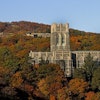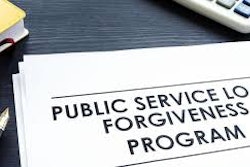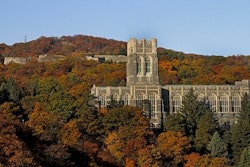Eight year a ago, Dr. William R. Harvey had a vision.
The Hampton University president was convinced
that with the right approach, the school could hold
its own at the highest level of collegiate competition. Now
that is is clear that Harvey’s vision was not just a case of
wishful thinking, there appears to be another school — Norfolk
State University (NSU) — ready to follow his lead.
Although Hampton is just in its second year of
National Collegiate Athletic Association (NCAA) Division
I competition, the institution is holding its own. The
Pirates, as they are athletically known, are members of
the Mid-Eastern Athletic Conference (MEAC), which is
one of the two Division I conferences composed of historically
Black colleges and universities (HBCUs). The
women’s tennis and softball teams have already won
conference titles and the football and basketball teams
are on the site.
“It took a lot of research and planning to make sure
that we would have a smooth transition [to Division I],”
says Dr. Dennis Thomas, Hampton athletics director.
“Dr. harvey provided the leadership for that. We felt our
program had developed to a point where we could
compete on the highest level of the NCAA — and that’s
Division I.”
Hampton’s move to Division I is just the first — if all
goes according to plan, Norfolk State will also make the
move to Division I this summer. Currently, NSU is
completing the application process with the NCAA and
expects to get a decision in it’s request by June 1. The
school is severing its Division II and Central Intercollegiate
Athletic Association (CIAA) ties in an attempt to
“keep up with the Joneses.”
“The exposure a school gets in Division I is not only
good for athletics, but good for the academic side,” says
William Price, Norfolk State’s athletics director. “And in
our situation, we’re in a hotbed. Our main rival, Hampton,
is seven miles away and Old Dominion (another
Division I competitor) is four miles form us. We’re
recruiting the same kids as they are for athletics and
academics, so it benefits us to move on too.”
It’s no secret why the former Division II school made
the move. Playing in Division I provides more visibility
for the school — especially through television appearances — and
generates more revenue from is athletic
programs.
On the other hand, more is required of schools that
move up to Division I. For example, they have to offer
more sports and scholarships — for men and women — than
Division II schools. There is also more of a
commitment needed for staffing, facilities and corporate
sponsorships. Additionally, they must alter their schedules
because the bulk of their competition must be
against division I schools in every sport offered by the
newcomers.
“It’s been quite an adjustment,” says Thomas, “but
it’s an adjustment we felt we could make. The biggest
adjustment is the level of competition. The schools we
play now have been in Division I for some time, so
there’s a consistency of good teams we’re competing
against across the board.
Eight-year Wait
Since moving to Division I, Men’s basketball has
presented its own special challenges for Hampton. The
Pirates can compete for the regular season conference
title, but they cannot play in the MEAC tournament.
That’s because of an NCAA rule which stipulates that a
Division II school moving up to Division I has to wait
eight years before it can play in a conference tournament
where the winner gets an automatic bid to the NCAA
championship tournament. The rule was instituted to
discourage schools form moving up to Division I, where
making the sixty-four-team championship garners a
handsome monetary reward. The reward increases with
each tournament game the team wins.
Hampton still has six more years to wait before it can
play in the conference tournament. If the Pirates were
allowed to play in the league tournament, the MEAC
would lose its automatic NCAA bid. The Pirates can go
to the NCAA tournament if they receive an at-large bid.
However, not being able to play in the conference
tournament poses the dilemma for both Hampton and
the MEAC, Hampton’s presence in the tournament would
be a major plus because the Pirates have a sizeable
student body (5,700) and a substantial fan base that
would help bolster tournament attendance. But since
the Pirates are not in the tournament
mix, Hampton fans don’t
attend.
There are options that Hampton
is currently pursuing which
could allow the school to play in
the conference tournament. The
school plans to appeal to the NCAA
to either waive the eight-year rule
altogether or shorten the waiting
period. The school can also appeal
to the MEAC, which determines
what team gets the NCAA’s
automatic bid, the regular season
champion or the tournament winner.
If the regular season champion
is chosen, Hampton has to be
ruled ineligible for the regular season
title in order for the Pirates to
be able to play in the conference
tournament.
Talks among the MEAC membership
to explore this option are already under way,
according to Thomas. “We’re going to exhaust all our
options,” he says.
There is also a strong possibility that when NSU, with
its 8,700 student body, goes to Division I it will join the
MEAC. That would give the conference another school
which has an exceptional alumni support system that
embraces athletics.
In any case, the Pirates plan to make their mark on
the MEAC is not a long-range goal. Thomas believes that
Hampton will continue to make inroads as a contending
sports power in the conference.
“We should be very productive in football,” he predicts,
“and we’re looking for `97-`98 to be a breakthrough
year for men’s and women’s basketball.”
Recruiting is critical to all athletic programs, but at the
Division I level, the competition is fierce. Schools that are
moving up have to make sure that the word gets out that
they now have a Division I program.
“Academically, Hampton has a well-known reputation
nationally,” says Thomas. “Now it’s a matter of informing
those junior college and high school students [that we
have Division I programs]. Across the board, I’m not so
sure that they’re aware that we’re Division I.
“We’re striving to have our athletic program match up
with out academic program,” he adds. “You can have an
outstanding academic institution and also have an excellent
sports program. That’s where we went to go.”
COPYRIGHT 1997 Cox, Matthews & Associates
© Copyright 2005 by DiverseEducation.com


















